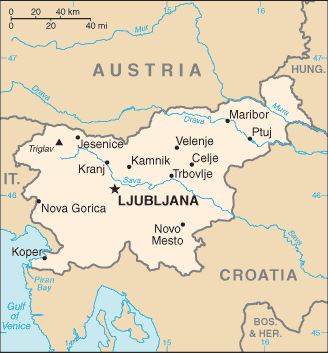|
Slovenia
|

|
Capital: Ljubljana
Population: 2,078,654
Brief History of Slovenia:
For almost one thousand years the Slovenes practiced a form of democracy where the Slovene farmers were ruled by the Duke, but had a say in how they were governed. Slovenia was ruled by the Habsburg Empire from the 1300s until after World War I in 1918. However, despite being part of the Habsburg Empire, Slovenia was able to maintain its unique culture and language.
Slovenia became part of the Kingdom of Serbs, Croats, and Slovenes in 1918, which later became the country of Yugoslavia. After World War II, Yugoslavia became a communist country led by Josip Broz Tito and somewhat ruled by the Soviet Union. After Tito died in 1980, Slovenia began to implement democracy in spite of what Yugoslavia said. Then, when the Soviet Union collapsed in 1989, Slovenia declared independence from Yugoslavia. Slovenia is still a stable democracy and plays a large role in world events despite its small size. In 2004 Slovenia joined the European Union.
The Geography of Slovenia
Total Size: 20,273 square km
Size Comparison: slightly smaller than New Jersey
Geographical Coordinates: 46 07 N, 14 49 E
World Region or Continent: Europe
General Terrain: a short coastal strip on the Adriatic, an alpine mountain region adjacent to Italy and Austria, mixed mountains and valleys with numerous rivers to the east
Geographical Low Point: Adriatic Sea 0 m
Geographical High Point: Triglav 2,864 m
Climate: Mediterranean climate on the coast, continental climate with mild to hot summers and cold winters in the plateaus and valleys to the east
Major cities: LJUBLJANA (capital) 260,000 (2009)
The People of Slovenia
Type of Government: parliamentary republic
Languages Spoken: Slovenian 91.1%, Serbo-Croatian 4.5%, other or unspecified 4.4% (2002 census)
Independence: 25 June 1991 (from Yugoslavia)
National Holiday: Independence Day/Statehood Day, 25 June (1991)
Nationality: Slovene(s)
Religions: Catholic 57.8%, Orthodox 2.3%, other Christian 0.9%, Muslim 2.4%, unaffiliated 3.5%, other or unspecified 23%, none 10.1% (2002 census)
National Symbol: Mount Triglav
National Anthem or Song: Zdravljica (A Toast)
Economy of Slovenia
Major Industries: ferrous metallurgy and aluminum products, lead and zinc smelting; electronics (including military electronics), trucks, electric power equipment, wood products, textiles, chemicals, machine tools
Agricultural Products: potatoes, hops, wheat, sugar beets, corn, grapes; cattle, sheep, poultry
Natural Resources: lignite coal, lead, zinc, mercury, uranium, silver, hydropower, forests
Major Exports: manufactured goods, machinery and transport equipment, chemicals, food
Major Imports: machinery and transport equipment, manufactured goods, chemicals, fuels and lubricants, food
Currency: tolar (SIT)
National GDP: $58,300,000,000
** Source for population (2012 est.) and GDP (2011 est.) is CIA World Factbook.
Back to Geography Home Page
